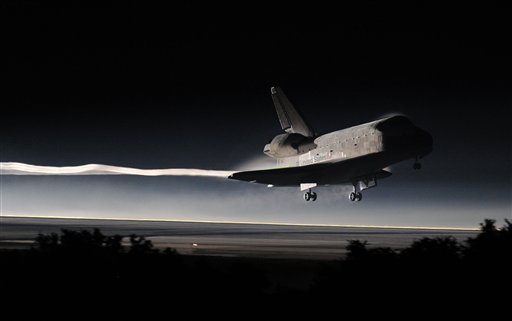CAPE CANAVERAL, Fla. — The space shuttle passed into history Thursday, the words “wheels stop” crackling over the cockpit radio for the very last time.
In an almost anticlimactic end to the 30-year-old program, Atlantis and its four astronauts glided to a ghostly landing in near-darkness after one last visit to the International Space Station, completing the 135th and final shuttle flight.
It was a moment of both triumph and melancholy.
“I saw grown men and grown women crying today — tears of joy to be sure,” said launch director Mike Leinbach. “Human emotions came out on the runway today, and you couldn’t suppress them.”
Now the spaceship and the two other surviving shuttles will become museum pieces, like the Mercury, Gemini and Apollo capsules and the Wright brothers’ flying machine before them. NASA astronauts, a dwindling breed, will have to hitch rides to the space station aboard Russian Soyuz capsules for at least three to five years. And thousands more shuttle workers will lose their jobs, beginning with a round of layoffs today.
The spaceship’s return was witnessed at the Kennedy Space Center and Houston’s Johnson Space Center by a relatively small crowd, mostly of NASA family and friends, compared with the 1 million who watched Atlantis lift off on July 8.
In Houston, flight director Tony Ceccacci, who presided over Atlantis’ safe return, choked up while signing off from Mission Control for the final time.
“The work done in this room, in this building, will never again be duplicated,” he told his team before the doors opened and the center filled with dozens of past and present flight controllers.
Shuttle commander Christopher Ferguson and his crew seized every opportunity to thank the thousands of workers who got them safely to and from orbit and guided them through the 13-day flight.
“After serving the world for over 30 years, the space shuttle’s earned its place in history. And it’s come to a final stop,” he radioed after Atlantis touched down just before dawn.
“We copy your wheels stop,” Mission Control replied. “Job well done, America.”
NASA is getting out of the business of sending cargo and astronauts to the space station, outsourcing the job to private companies.
The first privately operated supply run is expected later this year. But it will be an unmanned flight. It could be several years before private companies fly astronauts to the space station, which is expected to carry on for at least another decade. In the meantime, NASA will rely on the Russians for rides.
The longer-term future for American space exploration is hazy, a huge concern for many at NASA. President Barack Obama has set a goal of sending astronauts to an asteroid by 2025 and Mars in the mid-2030s. But the space agency has yet to even settle on a rocket design.
Thursday, though, belonged to Atlantis and its crew: Ferguson, co-pilot Douglas Hurley, Rex Walheim and Sandra Magnus, who during their mission delivered a year’s worth of food and other supplies to the space station and took out the trash.
They were greeted with cheers, whistles and shouts by 2,000 people who gathered near the landing strip — astronauts’ families and friends, as well as shuttle managers and NASA brass. Ferguson and his crew were later swarmed on the runway by well-wishers.
Saying goodbye
As a thank-you to workers — especially those losing their jobs — NASA parked Atlantis outside its hangar for several hours so employees could gather round and say goodbye. Close to 1,000 stood in the midday heat, waving American flags and paper fans and photographing the shuttle.
Angie Buffaloe wept. Three colleagues in her engineering office will lose their jobs today.
“I spend more time with these guys than I do with my family,” said Buffaloe, a 22-year space center worker. “We’ve been through everything: divorce, sick children, grandchildren. They’ve been there. We’ve shared life together … and now their last day is today.”
As of Thursday, the Kennedy Space Center work force numbered 11,500, down from a shuttle-era peak of 18,000 in 1992. Between 1,500 and 1,800 layoffs are coming today, and 2,000 more are expected in the coming weeks and months.
“I want them to stick their chests out proudly to say that they were a part of the most incredible era in American spaceflight, in anybody’s spaceflight,” NASA Administrator Charles Bolden Jr., a former shuttle commander, told reporters on the runway.
The shuttle was NASA’s longest-running space exploration program, making its inaugural flight in 1981.
Shuttles launched the Hubble Space Telescope and fixed its blurry vision; built the space station, the world’s largest orbiting structure; and opened the final frontier to women, minorities, schoolteachers, even a prince.
Two of the five shuttles — Challenger and Columbia — were destroyed, one at launch, the other during the ride home. Fourteen lives were lost.
Altogether, the shuttle fleet flew 542 million miles, circled Earth 21,152 times, carried 355 people from 16 countries and spent a combined 1,333 days in space — nearly four years.
The decision to retire the shuttle and focus on venturing farther into space was made seven years ago under President George W. Bush.



